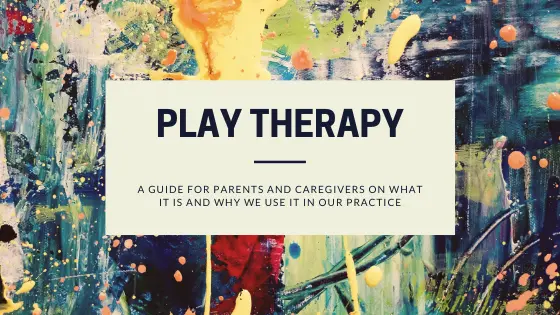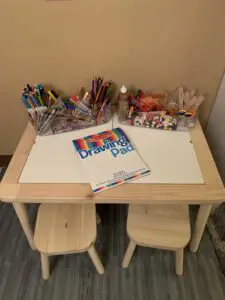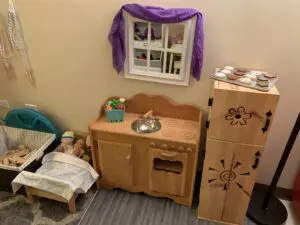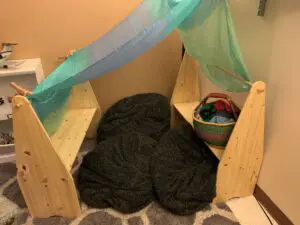At The Catalyst Center, we strive to help families create stronger, more empathetic relationships with one another by learning about emotions and how to express them in healthy and productive ways, and acquiring new ways of thinking, problem solving, and behaving. We typically use a combination of therapeutic options to work with children around a variety of issues, including Behavioral Issues, Complex Children, Trauma, ADHD, Anxiety, Depression, and Life Transitions.
Why use Play Therapy?
Play Therapy is based on the idea that children communicate and process differently than adults. For example, when we envision adults engaging in therapy, we may think about a conversation occurring. For children, communicating through conversation alone can be challenging because play is their natural language! It is truly amazing what a child can express through play that they may be unable to express through words alone.

Play Therapy utilizes toys, dollhouses, blocks, books, puzzles, games, art, sand trays, and puppets in therapeutic ways. Clinicians may also use storytelling, drama/role play, and creative visualization. At The Catalyst Center, we are fortunate to have a dedicated play room as well as a sand tray room. This article will give a brief overview of the various types of Play Therapy we offer at The Catalyst Center. There are benefits to them all, and we work with the child and family to find the best fit.
Directive Play Therapy
Directive Play Therapy is when the clinician is directing or guiding the session. The clinician may ask a child to draw a certain pictures or teach the child helpful relaxation techniques. The clinician may also utilize toys to help a child reenact an experience, thus enabling the child to work through their emotions. Because face-to-face conversations can be hard for children, the clinician and child can use puppets to facilitate a conversation.
Kendra Doukas is a Licensed Marriage and Family Therapist at The Catalyst Center. Here she gives a wonderful example of exploring emotions with a child in a directive manner:
“I believe it is very beneficial to help children understand how different emotions feel in their bodies. Most children will not simply tell you how they feel in their bodies, but when done in a fun and playful way seem to enjoy engaging with the activity! I work hard to help kids identify different emotions through the use of playing board games, but with a twist. My favorite is “Emotions Jenga” which is just Jenga but with emotion words written on each block. While we are playing the game we can work to identify emotions and talk about times we have felt those specific feelings. It also allows me to assess how well a specific child understands any given emotion.
Once I have established a child’s emotional lexicon and awareness I then move into helping the child to understand how specific emotions feel in their body. I like to do this by tracing the child’s outline on large paper. We then decorate the outline and create a drawing of the child. I have “special glasses” (which are really just silly dollar store sunglasses) which allow the child and I to be “detectives” and understand what is going on inside of their bodies. We each put on our special detective glasses and search throughout the drawing of the child’s body and the child can point out areas that feel tension or negative emotion. We can explore which emotions typically “live” in which areas of the child’s body (i.e. tightness in chest when they feel anxious or sinking feeling in their stomach when they feel sad). I have found that while many children will not or cannot engage in this activity with pure talk therapy, using this creative approach gets children excited to understand more about their emotional health.”
Non Directive Play Therapy
Non Directive Play Therapy is when the session is guided by the child. Typically, the child and clinician will enter the playroom and the child is allowed to play with whatever they want to. The theory behind Non Directive Play Therapy is that the child inherently knows what they need to do in order to communicate and process through their struggle. For example, imagine a child who has recently lost a parent, either to divorce, abandonment, or death. This child may want to play with the doll house and use the dolls to play out what they have experienced, or what they wish they could experience. They may use a toy ambulance to try and heal someone. Or they may arrest someone and use the police car to take that person away.
Dr. Chelsea Towler Campbell, one of the psychologists on our Child and Family Team, has this to say about Non Directive Play Therapy: “My favorite thing to do in play therapy is follow the imagination and creativity of the child. Whether this is through an art project, sand tray, storytelling, or play, it is an honor to get to join a kiddo on their unique journey to healing and wellness.“
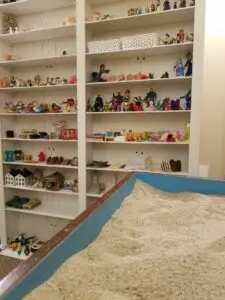
Sand Tray Therapy is a specific form of play therapy in which the child is presented with a table-top sand box and access to miniatures. Miniatures include small toys, blocks, figurines of animals and people, and objects from nature such as shells and rocks. The child chooses whatever miniatures they deem appropriate and creates a story or scene in the sand with the miniatures. Creating this scene can be helpful to the child as they process through emotions, problem solving, trauma, or grief. Oftentimes these scenes are highly symbolic of the child’s present day life and provides a format that allows a child to express themselves through play, their inherent form of communication.
Sand Therapy is also wonderful for teenagers and adults! It enables us to be able to process on a subconscious level and gain awareness and insight in a new way.
Dr. Chelsea Towler Campbell on Sand Tray Therapy: “Sand Therapy is one of my favorite techniques, as it allows the child to depict their inner world by placing miniature toys in the sand. No spoken words are necessary, but through this process the child is able to experience the feeling of being completely seen and understood.”
EMDR with Play Therapy
Eye Movement Desensitization and Reprocessing (EMDR) is a type of therapy that was originally used for trauma and is now used in several ways, including anxiety reduction. Children tend to respond very well to it. EMDR can be used in conjunction with almost any form of play therapy. For example, if a child is working on a sand tray about a traumatic event, it can be helpful to do EMDR during the sand therapy.
Filial Play Therapy
Several of our clinicians are trained in Filial Play Therapy. This type of play therapy involves working with the child and parents together. In Filial Play, the clinician plays with the child in order to model specific therapeutic interventions for the parents, and then works with the parents to start utilizing these interventions. The goal of Filial Play is to teach parents gain the therapeutic skills they need to help children through difficulties and create a stronger, more empathetic relationship between parent and child.
Whichever form of support your family or child needs, our highly qualified Child and Family Team is here to help you!

